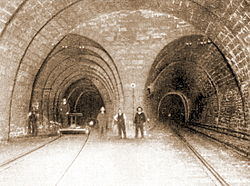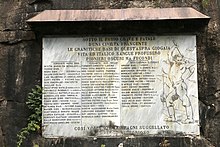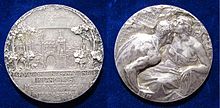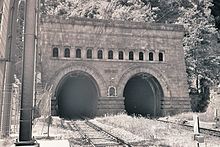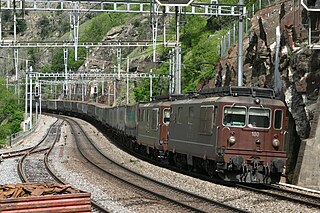
The Bern-Lötschberg-Simplon-Bahn (BLS), known between 1997 and 2006 as the BLS Lötschbergbahn, was a Swiss railway company. In 2006 the company merged with Regionalverkehr Mittelland AG to form a new company called BLS AG.

The Swiss rail network is noteworthy for its density, its coordination between services, its integration with other modes of transport, timeliness and a thriving domestic and trans-Alp freight system. This is made necessary by strong regulations on truck transport, and is enabled by properly coordinated intermodal logistics.

Domodossola is a city and comune in the Province of Verbano-Cusio-Ossola, in the region of Piedmont, northern Italy. It was also known as Oscela, Oscella, Oscella dei Leponzi, Ossolo, Ossola Lepontiorum, and Domo d'Ossola. The Peruvian aviation pioneer, Jorge Chávez died here in 1910 in an airplane crash.

The Simplon Pass is a high mountain pass between the Pennine Alps and the Lepontine Alps in Switzerland. It connects Brig in the canton of Valais with Domodossola in Piedmont (Italy). The pass itself and the villages on each side of it, such as Gondo, are in Switzerland. The Simplon Tunnel was built beneath the vicinity of the pass in the early 20th century to carry rail traffic between the two countries.
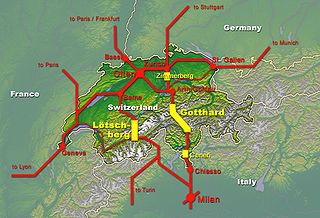
The New Railway Link through the Alps, is a Swiss construction project for faster north–south rail links across the Swiss Alps. It consists of two axes with several improvements along these rails including three new base tunnels several hundred metres below the existing apex tunnels, the 57-kilometre (35 mi) Gotthard Base Tunnel, the 35-kilometre (22 mi) Lötschberg Base Tunnel, and the 15-kilometre (9.3 mi) Ceneri Base Tunnel. Swiss Federal Railways subsidiary AlpTransit Gotthard AG and BLS AG subsidiary BLS Alp Transit AG were founded for this project and built the tunnels.

The Lötschberg is an Alpine mountain massif, usually associated with a major, historically important transit axis of the Alps in Switzerland with, at its core, the Lötschen Pass. The mountain pass, which culminates at nearly 2,700 metres above sea level, are part of the eastern Bernese Alps, whose main crest straddles the border between the cantons of Berne and Valais. The valleys concerned by the Lötschberg are those of the Kander in the Berner Oberland, with Kandersteg at the head of it, and a secluded side-valley of the Upper Valais, the Lötschental, with Ferden at the valley's entrance and at the bottom of the pass.
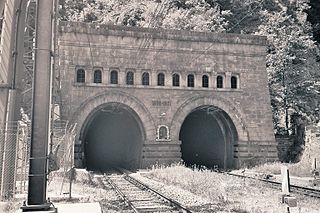
The Domodossola–Milan railway line is a major Italian railway route and an important part of the European rail network. It is one of Italy's busiest lines for both passenger and freight trains. The line connects Milan and Domodossola with Brig, an important Swiss railway junction, via the Simplon Tunnel. Direct passenger trains ran from Brig to Paris and Brussels and Luxembourg via Basel. The line runs through lower Varese Province, the valley of Ossola and along the shore of Lake Maggiore.

The Lötschberg line is a railway in Switzerland, connecting Spiez in the canton of Bern with Brig in the canton of Valais. It crosses the Bernese Alps, from the Bernese Oberland to Upper Valais, through the Lötschberg Tunnel in the middle of the line. Together with the Simplon Tunnel south of Brig, it constitutes one of the major railways through the Alps and an important north-south axis in Europe. The Lötschberg axis is backed by the lower and longer Lötschberg Base Tunnel, part of the New Railway Links through the Alps project.

The Western Switzerland Railways, were initially a joint operation of three Swiss railway companies, but these companies merged on 1 January 1872. The company was called the Western Switzerland–Simplon Railways from 28 June 1881. The SOS merged with the Bernese Jura Railways to form the Jura–Simplon Railways on 1 January 1890.
The Jura–Simplon Railways (JS), was a railway company that was formed in 1890. It was nationalised in 1903 as the largest railway company in Switzerland and integrated into the Swiss Federal Railways (SBB).
The construction and operation of Swiss railways during the 19th century was carried out by private railways. The first internal line was a 16 km line opened from Zürich to Baden in 1847. By 1860 railways connected western and northeastern Switzerland. The first Alpine railway to be opened was under the Gotthard Pass in 1882. A second alpine line was opened under the Simplon Pass in 1906.
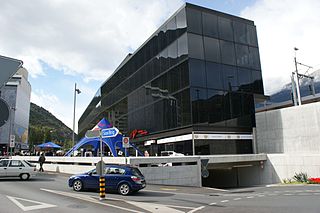
Visp railway station is a junction station at Visp, in the canton of Valais, Switzerland. It has a modern station building completed in 2007, and is served by two standard gauge lines and a metre gauge line.

Brig railway station is an important railway junction in the municipality of Brig-Glis, in the Canton of Valais, Switzerland. Opened in 1878, it is adjacent to the northern portal of the Simplon Tunnel and is served by two standard gauge lines. Another two metre gauge lines serve the physically adjacent Brig Bahnhofplatz railway station.

Iselle di Trasquera railway station serves the village of Iselle and municipality of Trasquera, in the region of Piedmont, northwestern Italy. Opened in 1906, the station is at the southern portal of the Simplon tunnel, on the Simplon line, between Brig, Switzerland and Domodossola, Italy. It is also the border station between Italy and Switzerland. All rail services to and from the station are operated by BLS AG, a Swiss company.

The Domodossola–Locarno railway line, informally called the Centovallina in Switzerland and the Vigezzina in Italy, is a metre-gauge railway negotiating the dramatic mountainous terrain between Domodossola, Italy, and Locarno, Switzerland. It passes through the Vigezzo Valley and Centovalli.

The Simplon Railway is a line that links Lausanne in Switzerland and Domodossola in Italy, via Brig. The 20 km (12 mi)-long Simplon Tunnel is a major part of it. The line between Lausanne and Vallorbe is sometimes considered to form part of the line, making it 233 km (145 mi) long.

The Bern–Thun railway line is a double-tracked, electrified railway line that runs through the Aare valley in the Swiss canton of Bern. It is part of the Lötschberg-Simplon axis between Germany and Italy. It was opened in 1859 by the Swiss Central Railway.
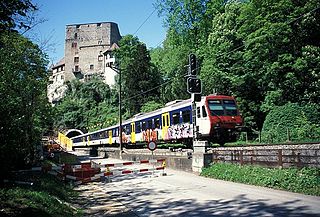
The Basel–Biel/Bienne railway line is a standard gauge railway line of the Swiss Federal Railways (SBB) and the BLS AG. It runs from Basel SBB along the Birs in the French-speaking Jura to Delémont and Biel/Bienne. The traffic on the line is shown in table 230 of the official timetable.

The Compagnie de la Ligne d’Italie, or Ligne d’Italie for short, was a former Swiss railway company that established in 1859. In 1874, the Ligne d'Italie became part of the Compagnie du Simplon. The Compagnie du Simplon, Ligne du Simplon or Simplon for short, merged into the Western Swiss Railways in 1881.

Brig, known as Brig in German and Briga in Italian, is a town in the canton of Valais, in the commune of Brig-Glis.
